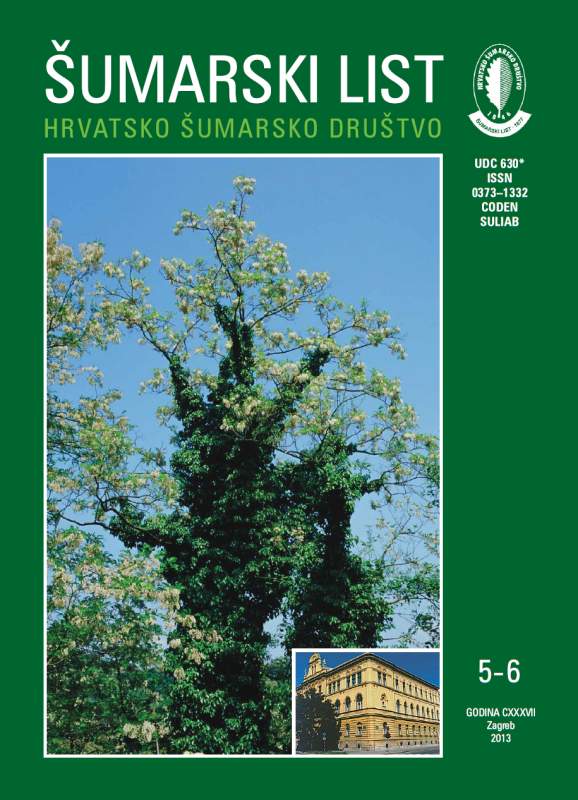
broj: 5-6/2013
pdf (4,26 MB) |
|
||||||||||||||
| RIJEČ UREDNIŠTVA | ||
| Uredništvo | ||
| FORESTRY WITH AND WITHOUT A TAX ON NON-MARKET FOREST FUCTIONS pdf HR EN | 277 | |
| IZVORNI ZNANSTVENI ČLANCI | ||
| Krešimir Greger, Ksenija Šegotić, Tomislav Grladinović, Kristina Bičanić, Ivana Perić | UDK 630* 836 (001) | |
| CRITERIA RANKING IN ASSESSING TECHNOLOGICAL PROCESS CAPABILITY IN FURNITURE MANUFACTURING pdf HR EN | 279 | |
| Branislav Trudić, Marko Kebert, M. Boris Popović, Dubravka Štajner, Saša Orlović, Vladislava Galović, Andrej Pilipović | UDK 630* 165 | |
| THE EFFECT OF HEAVY METAL POLLUTION IN SOIL ON SERBIAN POPLAR CLONES pdf HR EN | 287 | |
| PRETHODNO PRIOPĆENJE | ||
| Behiye Banu BILGEN, Murat ALAN, Yusuf KURT | UDK 630* 165 | |
| Importance of Effective Clone Number in Seed Orchards: A Comparative Study on Seven Conifer Species in Turkey pdf HR EN | 297 | |
| M. Georgieva, G. Georgiev, D. Pilarska, P. Pilarski, P. Mirchev, I. Papazova-Anakieva, S. Naceski, P. Vafeidis, M. Matova | UDK 630* 453 | |
| FIRST RECORD OF ENTOMOPHAGA MAIMAIGA (ENTOMOPHTHORALES: ENTOMOPHTHORACEAE) IN LYMANTRIA DISPAR POPULATIONS IN GREECE AND THE FORMER YUGOSLAVIAN REPUBLIC OF MACEDONIA pdf HR EN | 307 | |
| Abstract The entomopathogenic fungus Entomophaga maimaiga Humber, Shimazu & Soper (Entomophtorales: Entomophtoraceae) was found for first time in populations of gypsy moth, Lymantria dispar (L.) (Lepidoptera: Erebidae), in Greece and the Former Yugoslavian Republic of Macedonia (FYROM) after its introduction in Bulgaria in 1999. Monitoring studies were conducted in 2012 in oak stands in three sites in the Xanthi region in Greece, and in three sites in FYROM in the Prilep region. Gypsy moth larvae, predominately in fourth to sixth instar, were collected in May and June. During laboratory rearing, mortality of gypsy moth larvae collected in two sites in Greece ranged from 36.4–89.3%. Larval mortality of L. dispar in the three sites in FYROM ranged from 16.7–87.8%. Dead larvae were analysed under light microscopy for presence of E. maimaiga and other entomopathogens. E. maimaiga was recorded from one site in Greece (Kidaris vill.), and in all study sites in FYROM (Toplica, Belovodica and Krushevo vill.). Azygospores of E. maimaiga were found in the bodies of 78.6% of gypsy moth larvae from Kidaris, and in 8.3–16.3% of the larvae from sites in FYROM. Recent records of E. maimaiga in Serbia and the European part of Turkey, and present findings in Greece and FYROM, indicate that the fungus most probably has invaded gypsy moth populations in other parts of Balkan Peninsula. Key words: gypsy moth; fungal entomopathogen; first records | ||
| STRUČNI ČLANCI | ||
| Željko Španjol, Roman Rosavec, Damir Barčić, Josipa Filipović | UDK 630* 43 | |
| FOREST FIRES IN THE AREA OF FOREST ADMINISTRATION BRANCH SENJ 1991–2009 pdf HR EN | 313 | |
| Marilena Idžojtić, Igor Poljak, Marko Zebec | UDK 630* 271 | |
| DETERMINATION OF TREES AND SHRUBS IN THE LISIČINE ARBORETUM WITHIN THE PROJECT OF REVITALISATION – PART 2 pdf HR EN | 325 | |
| KORICE | ||
| Boris Hrašovec | ||
| Saturnia pyri – Great peacock moth, goliath among native moths and valuable proof of our preserved forests PDF | 361 | |


